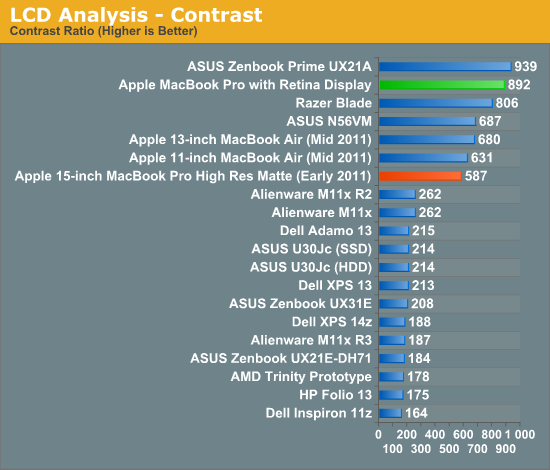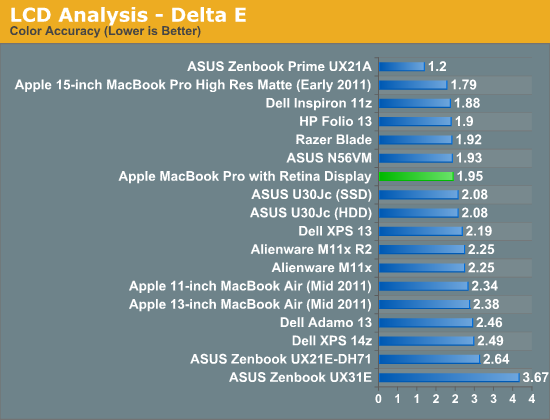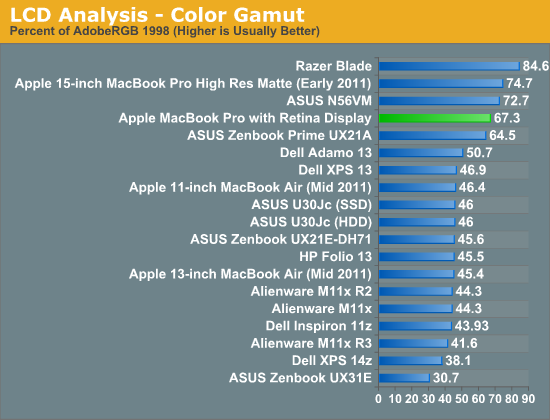The next-gen MacBook Pro with Retina Display Review
by Anand Lal Shimpi on June 23, 2012 4:14 AM EST- Posted in
- Mac
- Apple
- MacBook Pro
- Laptops
- Notebooks
The Retina Display in Numbers
I already published preliminary analysis of the Retina MacBook Pro’s display. In short brightness is down a bit, black levels are considerably improved and contrast as a result takes a huge step forward compared to previous models. My personal MacBook Pro used the anti-glare matte screen and the improvement in contrast ratio compared to that reference is over 50%.



Apple made no mention of impact to color accuracy or color gamut. It turns out that the omission was for good reason, the Retina Display offers no improvement along either vector. The numbers show a slight regression compared to last year’s panel but the difference is imperceivable.


Technically Apple’s use of the word Retina in reference to a display only refers to the inability for the human eye to resolve individual pixels at a specified distance (18-inches for the MacBook Pro). In practice however Apple has delivered tightly integrated IPS panels with wonderful performance characteristics as a part of the Retina brand. I do hope that for the years to come Apple does not compromise on these fronts.










471 Comments
View All Comments
vision33r - Sunday, June 24, 2012 - link
When a PC laptop goes on sale, the listed price is never the actual purchase price.A $1000 Dell usually end up getting sold for $800 or less after coupons and Dell runs sales all the time. Same goes for HP.
Apple almost never do a sale until the model is outdated, the only discount is the education one.
It's a certain that all PC laptop makers have to cut corners to make a profit, competition is fierce. Most buyers are more price sensitive these days then specs.
duploxxx - Monday, June 25, 2012 - link
Many manufacturers allow options in there designs towards more cutting edge technology...I have a full HD display in a 15"since 2008, same for my SSD.... just a matter of cutting cost for low profile. This differentiate with apple who already put these in the baseline... call bleding edge wathever you want but I am sure my Laptop cost probably a few 100$ less with eluminated keyb, optimus etc.... but it hasbn't got the shiny apple logo :)
Johnmcl7 - Saturday, June 23, 2012 - link
Sony have been offering 13.1 1920x1080 screens for a few years which admittedly isn't nearly as high as the new Macbook screen but given Sony have been frequently criticised for offering such a pointlessly high resolution it's little surprise they haven't developed it further.When Apple do it however they get praised for their innovation and bringing the market forward when in reality they're a while behind other companies who are genuinely innovative and getting the technology out there.
John
Super56K - Saturday, June 23, 2012 - link
I'm not sure you understand. It's rendered at double the resolution, but presented at the same size as 1440x900 or 1900x1200 on a 15" screen. You gain clarity rather than real estate.What other notebooks out there can do that?
ananduser - Saturday, June 23, 2012 - link
Lol...you just described DPI scaling. The retina mb just offers ready made presets. To achieve the same effect on the Z simply change the DPI scaling within the native resolution.KoolAidMan1 - Saturday, June 23, 2012 - link
Scaling in Windows doesn't work the same, nor is it targeted towards such specific resolutions. Anand talks about this himself in the review.Hopefully Windows 8 outside of the Metro UI addresses this.
OCedHrt - Sunday, June 24, 2012 - link
That's because Windows only goes up to 1.5 instead of 2. But at 1920x1080, 1.5 gives you 1280 x 720. Do you really want to go that small?ananduser - Sunday, June 24, 2012 - link
OMG...it's been said 10 times already in the comments. Windows goes all the way up to 200%. Anand does not know Windows setting well enough.ananduser - Sunday, June 24, 2012 - link
That't the idea, scaling should *NOT* be dependent on specific resolutions. It should be agnostic. That's what Windows does because it's supposed to power the world's computers, macs included.dagamer34 - Sunday, June 24, 2012 - link
Windows 8 addresses this by providing an easy way to serve up high resolution assets for the OS to use depending on the DPI of the machine. It takes all of the guesswork out of the developers hands with no extra code needed.